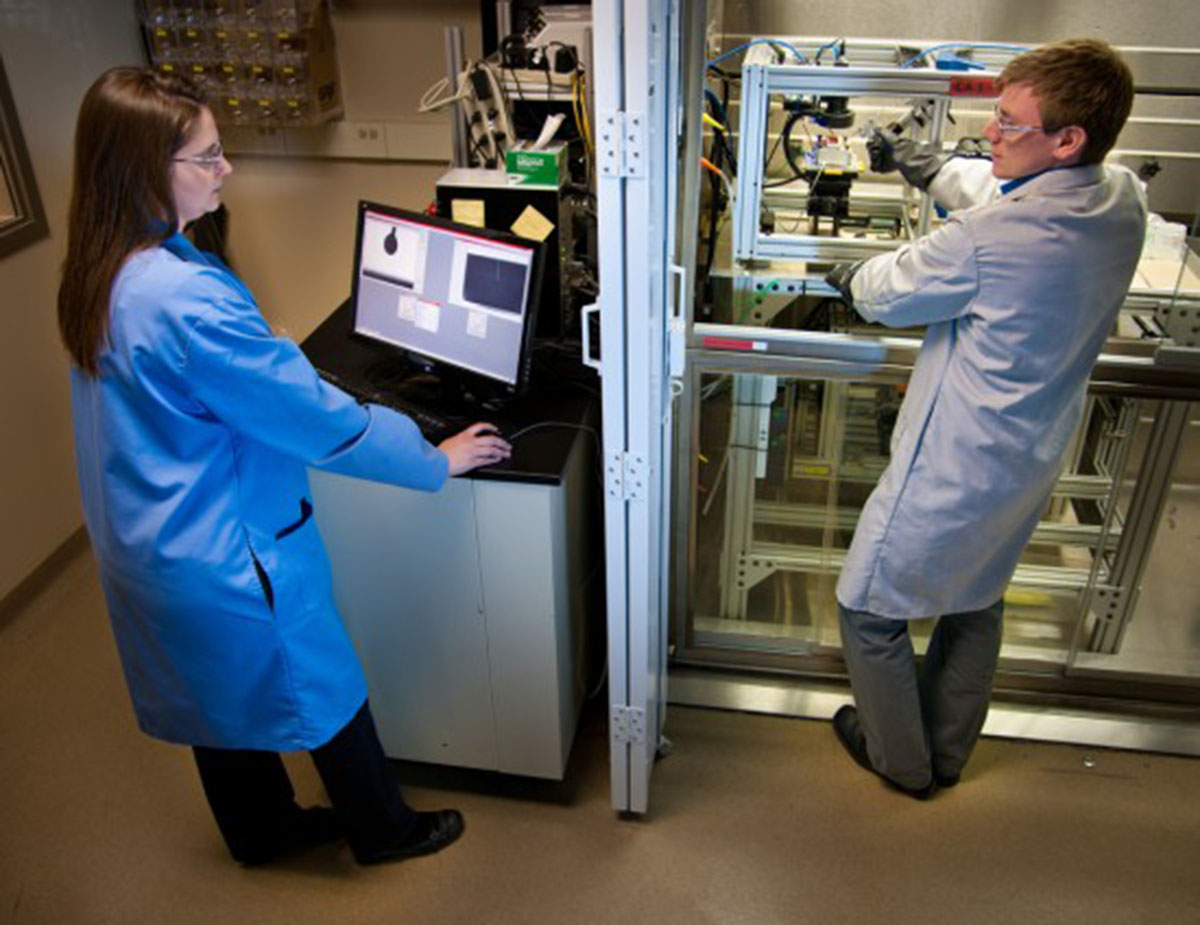On a work bench in a scientific research lab at the University of Pennsylvania in Philadelphia sits a box lined with gold and invisible nanotubes. A clear plastic tube runs through the middle of the box, and something like a pin cushion attached to blue and red wires hangs from its end. As air is piped through the clear plastic tube, signals are sent through the blue and red wires to a computer. Near the apparatus is a vial filled with blood providing a chemical scent the device can "sniff" through the clear plastic tube.

This device, termed an "electronic nose," is the invention of Dr. George Preti, an organic chemist who has been studying human scent for the last four decades. He has used his own nose and electronic sensors to identify odors that match functions of the human body. He has studied blood, sweat, tears, and other secretions to turn smell into a diagnostic test. And most recently he has been working on the question of whether ovarian cancer has a smell.
Diseases Cause Subtle Changes in the Ways People Smell
Human beings are constantly emitting odors. Tens of thousands of chemical waste products are released from the body in urine, feces, sweat, tears, or blood, or simply released into the air above the skin. Metabolic diseases like kidney failure or untreated diabetes alter the way the body breaks down chemicals into waste products and can make someone distinctively stinky.
The best known diagnostic sign of a condition called diabetic ketoacidosis is breath that smells like nail polish remover. The odor from the breath is noticeable, but the odor in the urine can be overpowering.
An inability to process the amino acid phenylalanine so that it spills over in the urine, phenylketonuria, makes people smell something like a damp basement or gym socks that weren't put in the laundry. People who lack a digestive enzyme and have the condition trimethylaminuria smell fishy. An overactive thyroid gland or excessive insulin production by the pancreas can lead to excessive perspiration which causes the well known body odor of bacteria thriving in sweat. And there is even a condition called ketoaciduria, in which the body lacks a group of enzymes to process the amino acids isoleucine, leucine, and valine, which makes the urine smell like maple syrup.
Read More: Alternative Cancer Treatment: Scientific Exploration of Herbs
Why Try to Sniff Out Ovarian Cancer?
Before Dr. Preti's research, there was not, however, an easy way to detect the odor of ovarian cancer. There isn't any other easy, reliable way to detect the disease during its early, treatable stages, either. Doctors usually detect cancers by CT or MRI scans or by feeling for lumps. Because ovarian cancer causes no symptoms or only vague symptoms that overlap many other disease conditions during its early stages, doctors simply do not know to order the tests that would detect this kind of cancer before it has begun to spread.
Ovarian cancer is detected more or less by accident in its early stages about 15% of the time. When the cancer is detected in Stage 1, before it has invaded other tissues, about 92% of women live at least 5 years. But if ovarian cancer is detected at a later stage, only 27% of women live as long as 5 years after they are diagnosed.
A Dogged Search For A New Method Of Cancer Detection
George Preti and his coworkers are not exactly the first people to tackle the questions of how to detect cancer by scent. At least in well publicized experience, the first individual known to medical science to detect cancer by scent was not even a human. The first recorded example of cancer detection by scent involved the keen nose of a dog, a Doberman pinscher-collie mix.

In 1989, two doctors wrote a letter to the medical journal Lancet in which they described their treatment of a woman who had come in for examination of a mole because her dog was very upset by it. Even when she was wearing short, the dog would point in the general direction of the mole. As it grew, the dog even tried to bite it off. When the woman came to their offices to get the dermatologists to take a look at the growth, it turned out to be a potentially deadly melanoma.
Since that experience, doctors have reported cases in which dogs (usually German shepherds or Labrador retrievers) have been trained to sniff out colon cancer, lung cancer, and prostate cancer. It might be possible to train a dog to detect ovarian cancer, too, but the problem with this approach is that scientists don't really know what it is that the dog detects that identifies the cancer. Dogs tend to be very specific and very accurate in sniffing out certain kinds of cancer in their humans, but doctors still won't order a biopsy or start chemotherapy on the basis of a dog pointing or barking "Woof."
Why Cancer Is Hard to Sniff Out
Modern medicine actually has developed reliable "sniff tests" for certain conditions. Anesthesiologists measure carbon dioxide levels in the breath to make sure they have inserted breathing tubes down the right "pipe." Cardiologists performing heart transplants measure a group of chemicals known as alkanes as an early warning system for organ rejection. And pulmonologists can determine whether asthma medications are working by measuring the amount of nitric oxide in the patient's breath.
Cancer cells, however, don't release just one signature chemical. They release groups of chemicals, some of which can also be made by bacteria living in the lungs, in the colon, or on the skin. A chemical sniffer has to have the ability to detect a pattern of cancer chemicals against the background noise of thousands and thousands of other chemicals produced by the body and by microorganisms that live in or on it.
Read More: Cancer Detection By Breath Test: New Approach To Early Diagnostics
Electronic Nose for Ovarian Cancer Still a Work in Progress
This complexity is the reason that Dr. Preti and his colleagues have not yet created a reliable sniff test for ovarian cancer. And it's important to note that Preti isn't limiting his efforts to detecting ovarian cancer by odor. He is also doing blood analyses with an instrument known as gas chromatograph-mass spectrometer.
But Preti and many other experts in the field are convinced that someday it will be possible to sniff out ovarian cancer while it is still treatable. In the meantime, perhaps some other researchers will train man's best friend to do the job.
- Bijland LR, Bomers MK, Smulders YM. Smelling the diagnosis: a review on the use of scent in diagnosing disease. Neth J Med. 2013 Jul-Aug.71(6):300-7.
- Williams H, Pembroke A. Sniffer dogs in the melanoma clinic? Lancet. 1989 Apr 1. 1(8640):734.
- Photo courtesy of Mark Tighe by Flickr : www.flickr.com/photos/mjtmail/4163379369/
- Photo courtesy of U.S. Army RDECOM by Flickr : www.flickr.com/photos/rdecom/7136335641/


Your thoughts on this